A very long time in coming, however right here we go! This marks the start of what would be the most important enterprise in Cogmind’s UI growth historical past: making all the pieces greater. Not simply the map, for which zooming was lately applied as a toggleable possibility, however all of the textual content as effectively.
This can be enjoyable since I do love me some interface work, as evidenced by the huge variety of non-compulsory QoL options I’ve launched over time, however regardless of pouring many hours into accessibility and streamlined gameplay earlier than, this specific function took the longest to get to.
Again in Cogmind’s early years I gave robust consideration to implementing it then–put collectively some mockups, mentioned choices with the neighborhood, and so forth, however the time wasn’t proper. Again then I couldn’t nail down what can be essentially the most excessive (however nonetheless acceptable) choices. We didn’t but know what affordable limits to placed on such a function, as in what’s the absolute furthest it may go with out compromising different elements of the sport design. It needed to wait.
Being the way in which a participant interacts with all of a recreation’s content material, UI is of course central to the expertise, thus one of the elementary points a recreation’s design wants to handle is matching up that design with its corresponding system necessities, together with the show gadget!
To take an excessive instance, there are clearly completely different issues when creating for cell vs desktop, and the outcomes of the completely different selections made to optimize a design for the goal platform can be why ports between numerous platforms don’t at all times come out the identical, whether or not technically or when it comes to really feel.
Not surprisingly, beginning within the 2010s there started a development in direction of creating video games with a view to finally goal as many alternative platforms as doable (desktop and consoles being the commonest crossovers), and it was very fascinating to see participant reactions to this development, particularly PC gamers lamenting how video games had been altering to make sure they might accommodate consoles as effectively. A mandatory evil if you wish to maximize income, I assume 😛
Discovering center floor in order that extra folks can take pleasure in a type of leisure is in some methods additionally a noble objective, though this naturally waters down the expertise on the similar time. The extra strict your necessities, the extra you may make assumptions concerning the goal participant’s expertise, and in flip optimize a design for what you recognize to be true. Mainly if achieved proper, the tip outcome can be higher, for that exact group of gamers.
And that’s the backdrop for the way Cogmind got here to be born in its authentic kind over a decade in the past, eager to have a big sufficient terminal grid to have the ability to concurrently present an enormous quantity of information at once–Cogmind’s terminal dimensions are simply the biggest of any roguelike, and in addition higher help very massive and lively maps–Cogmind has the biggest maps of any subterranean roguelike, and in addition by far essentially the most lively maps, with numerous entities milling about doing their very own factor, some kind of necessary than others, however all value of being conscious of for numerous causes.
The scope couldn’t be so formidable with out what I made a decision on the time: This design will lean actually closely into having a big display to play on. “Massive” which means bodily massive, decision being irrelevant since we’re speaking a couple of conventional terminal right here, all that data merely showing greater when the display is greater, the show at all times being divided into no less than a 160×60 grid. (By comparability, the classics use 80×25, and a few later roguelikes use one thing in between, so Cogmind has almost 5 instances as a lot show space as the unique roguelikes, or a number of instances what’s present in another later roguelikes.)
Quick ahead greater than 10 years, and a a lot higher portion of individuals now play video games on laptops, to not point out a higher number of gamers have begun discovering and turning into fascinated about Cogmind, so the demand for various interface choices is clearly rising ever bigger.
Even when not the unique audience, I at all times needed to accommodate extra folks when doable, and though my intention was to attend till someplace round 1.0 to experiment with the chances, it’s additionally turning into clear that there’s no concept when Cogmind 1.0 will really occur 😛
Fortuitously at this level we even have a really clear concept of Cogmind’s growth wants, how gamers work together with the sport, and just about all of the UI issues and limitations that we’d have to have in mind to design the “most excessive” various interface layouts that might nonetheless work.
So it’s time to do this.
UI Necessities
Cogmind’s authentic UI idea had two primary necessities: a sufficiently massive map view space, and a persistently seen record of all elements.
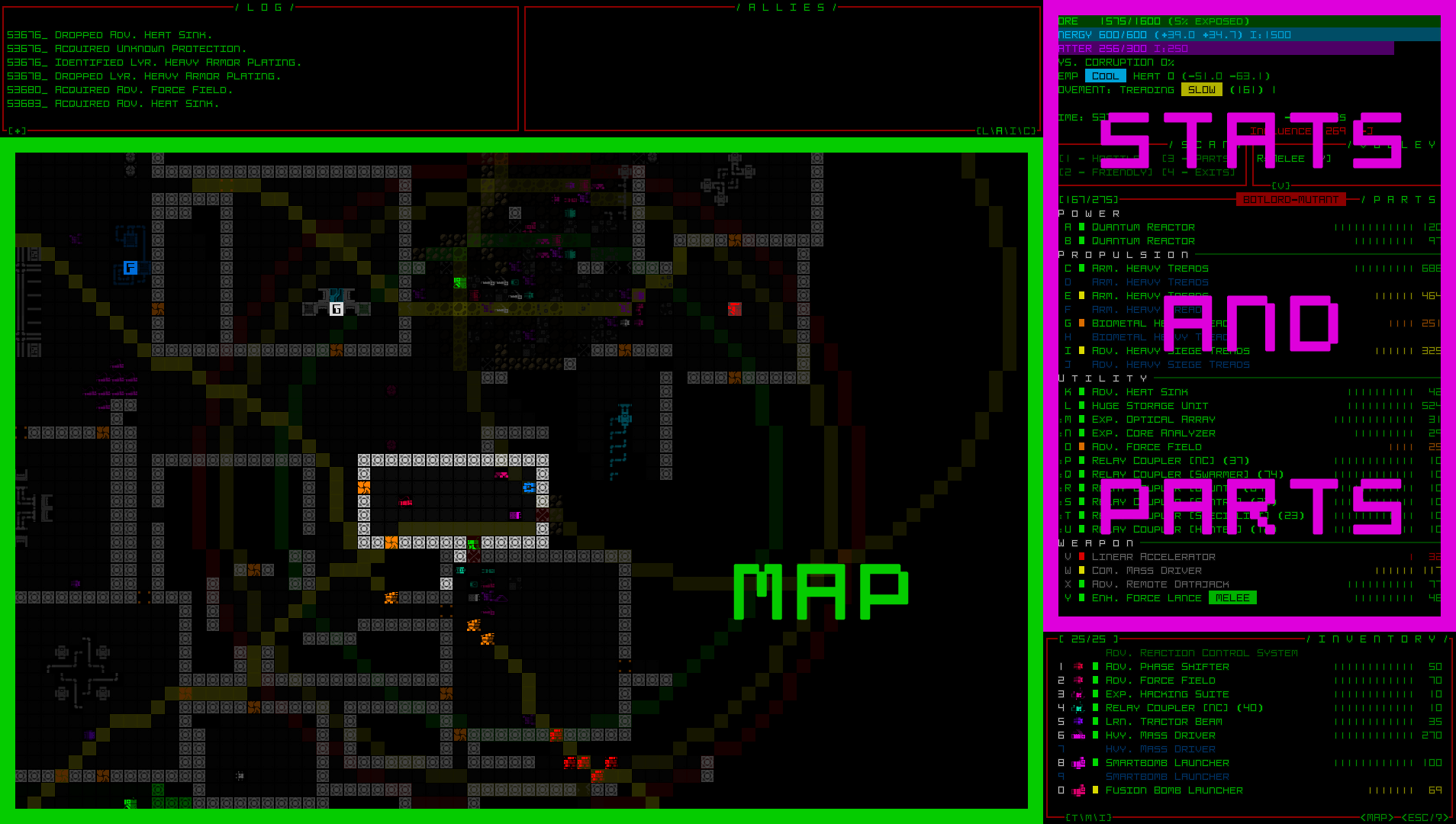
Interface elements we will’t actually do with out, even when some had been to take a barely completely different kind. Fundamental stats reflecting present assets and standing are additionally fairly necessary!
Components Listing
In contrast to just about each different roguelike during which the participant has a principally persistent set of kit, Cogmind’s elements record includes objects which might be topic to frequent tweaking and toggling, or no less than warrant a lot nearer turn-by-turn remark resulting from harm and/or standing modifications. The record additionally contains as much as 26 completely different slots directly, whereas different roguelikes typically have half that, at most.
As such, having the ability to see and work together with this record in its entirety always is kind of necessary, so it was given its personal space on the interface. That may at all times be there.
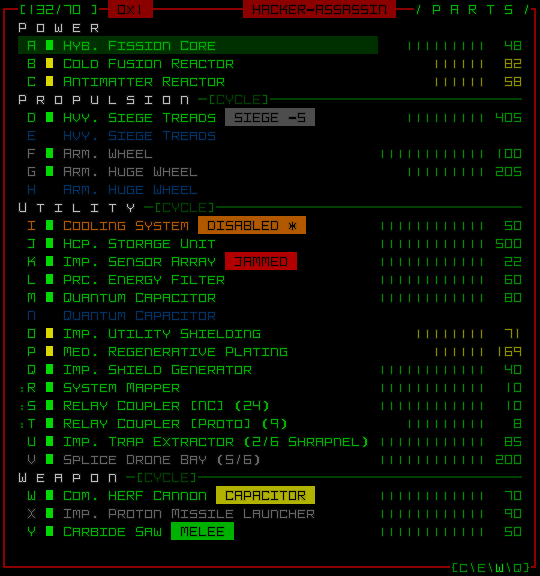
Pattern elements record.
Map View
Seeing the map, the place many of the motion occurs, can be kinda necessary, too. However how a lot of it can we wish to see directly? How massive does this view want to be?
Cogmind was not designed to require widescreen help. The truth is, the UI structure we’ve got was initially constructed to suit snugly in 4:3 side ratio, solely increasing horizontally to fill more room as obtainable.
Subsequently though it may be expanded to indicate extra space, underneath that structure the minimal map view space allowed was set to 50×50 (in terminal dimensions that is really 100×50, as a result of map cells are sq. slightly than rectangular, every occupying two terminal cells).
The quantity 50 is extremely central to Cogmind’s design, as a result of virtually no weapons or lively intel ought to have a spread that may exceed the realm a participant can see by default. Cogmind being a recreation targeted on ranged fight, repeatedly getting attacked from out of view wouldn’t be nice, neither is having information on enemies roaming round you in a number of instructions, recognized however out of view. These and different drawbacks of a small view space don’t make for an optimum play expertise.
Assuming map view dimensions of fifty×50, inserting Cogmind on the heart means the participant can see out to a distance of roughly 25 or extra in any path. So ranges ought to for essentially the most half be saved inside that worth.
Another excuse to have a decently massive map view within the first place is, once more, the sheer dimension of maps to discover, and the doubtless excessive stage of native exercise on the market. A view space as massive as 50×50 can nonetheless solely see a mere 1/sixteenth of the realm comprising main maps–more for some smaller maps, and even much less for bigger ones.
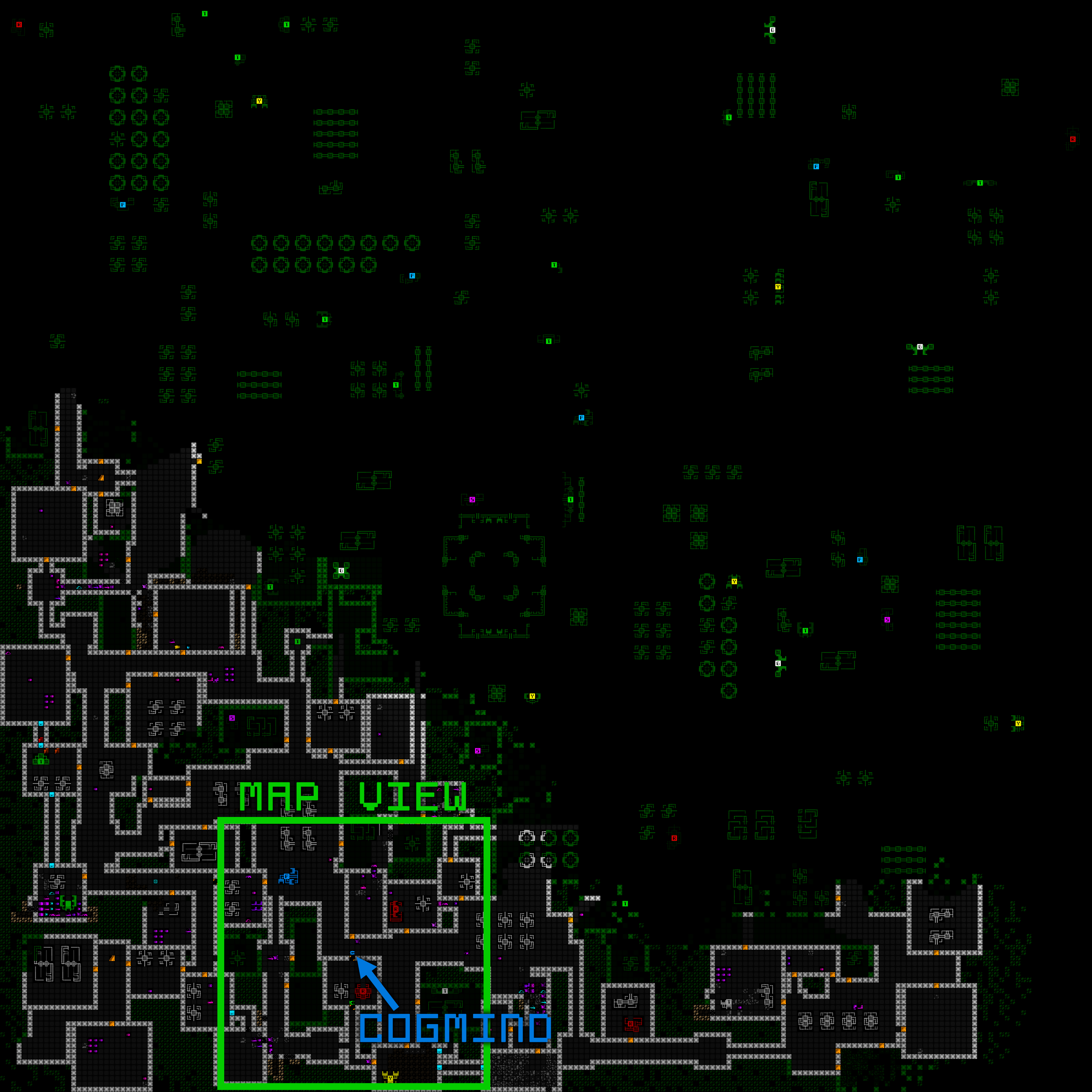
Demonstrating a 50×50 space seen round Cogmind as seen whereas exploring a map (export offered by Mojo).
Like some roguelike classics, in TGGW it’s fairly good that you may see your entire map directly with none scrolling in any way, although it was clearly designed for such from the outset, with correspondingly brief assault and sight ranges, and a smaller quantity of concentrated content material per flooring, making every flooring expertise brief and candy.
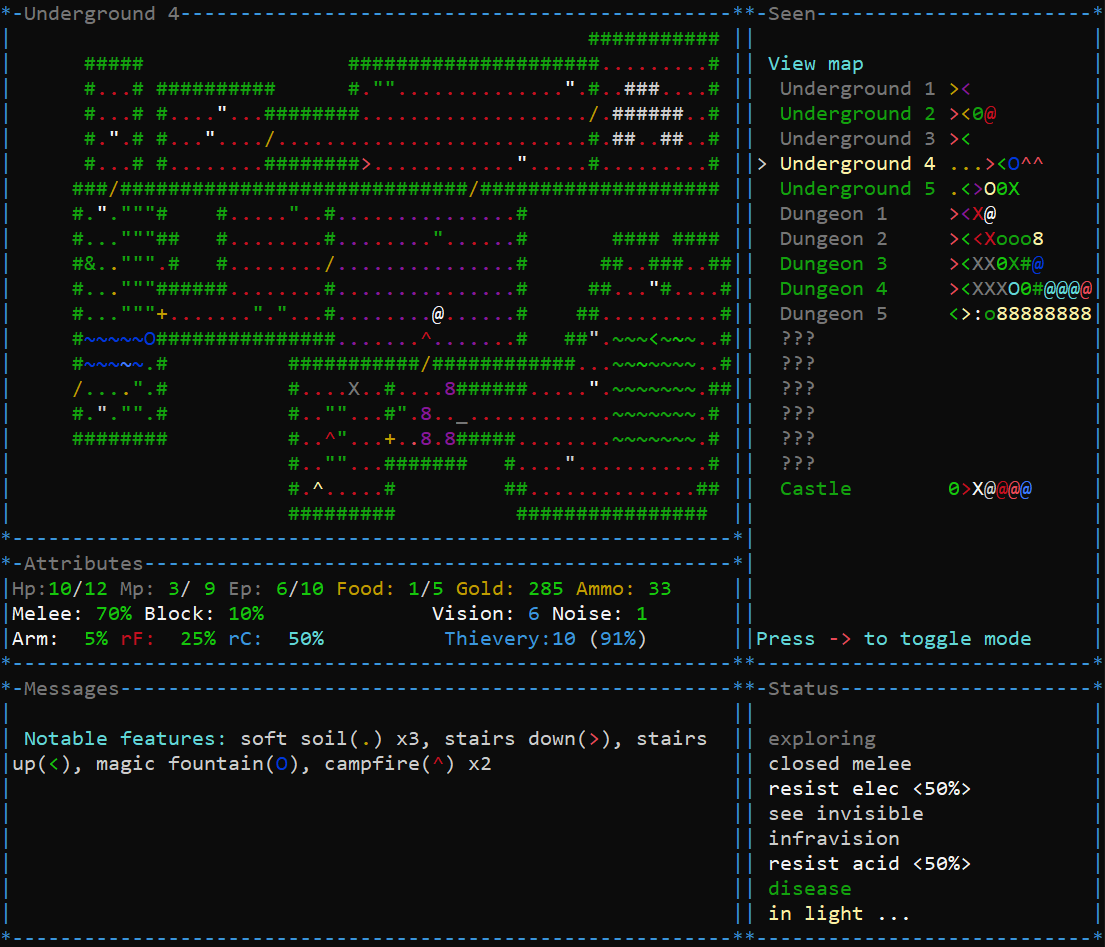
Pattern screenshot from The Floor Provides Approach, with a mostly-explored map flooring exhibiting its structure.
Cogmind wants area for the scope it goals to fill, and a UI to match that, or no less than facilitate exploring it as a substitute of getting to scroll 1,000,000 instances to kind a psychological image, or continually checking completely different instructions to pay attention to probably impactful developments on the market.
Mainly from a gameplay standpoint roguelikes are greatest constructed with an optimum interface designed with optimum play in thoughts.
However now let’s swap gears and see what we will do when it comes to making all the pieces bigger by breaking that design whereas making an attempt to mitigate the downsides 😀
Different UI Layouts, an Evolution
Again in late November over on Patreon (and made obtainable to everybody a bit of later) I put collectively a diagram and primary clarification for a hypothetical route Cogmind’s interface may tackle the way in which to one thing that will increase the potential variety of gamers for which it’s appropriate.
Right here I’ll be diving into that diagram once more to provide a extra organized abstract with some additional particulars.
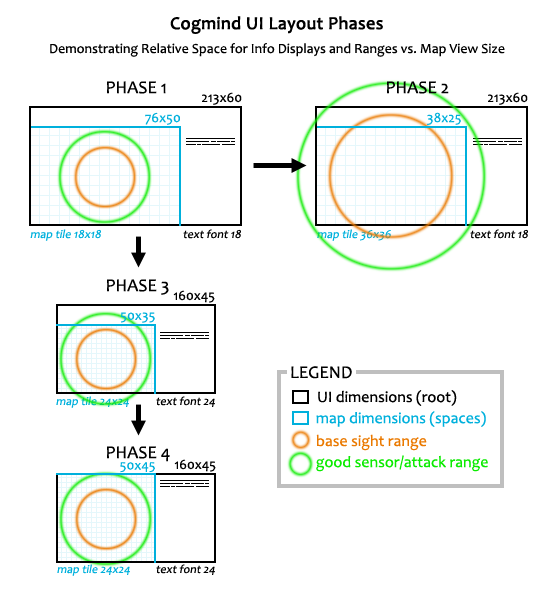
Normal overview of potential semi-modal and modal UI layouts for Cogmind. See under for clarification.
Part 1
The primary section is Cogmind’s present UI structure since mid-2013 once I began the industrial model (the 7DRL model was barely completely different, at all times utilizing 4:3). I’m utilizing 76×50 for the map dimensions since that’s the default map view width for 1080p customers, which comprise the vast majority of gamers. As you’ll be able to see, each the bottom sight vary and good sensor/assault ranges are safely throughout the map view (these photos are all drawn to scale!).
Part 2
Earlier than I began contemplating an instantaneous transfer to an across-the-board enhance in cell dimension, I experimented with simply zooming the map. Early experiments had been promising sufficient to persuade me to only do it–plow via the implementation and see what it appears like in observe (I wrote a collection on that).
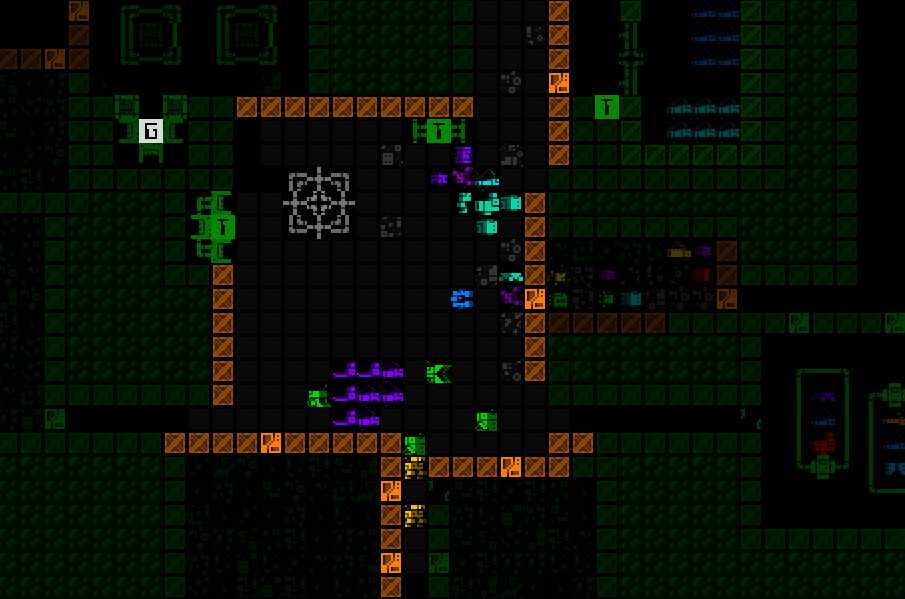
Fast map zoom recording taken whereas implementing the associated animation work.
One argument for prioritizing map zoom over determining the right way to enlarge the remainder of the UI (if even doable) may very well be that such an method would possibly simply be passable for some gamers who say they’d favor “a bigger interface.”
Most play time is spent wanting on the map, in any case, and though this could not influence textual content in the remainder of the interface, people are higher at recognizing acquainted letters at smaller sizes than, say, game-specific monochrome sprites on a map. Whereas Cogmind’s tiles had been designed to be pretty recognizable through normal form, that’s nonetheless not corresponding to our present familiarity with letters (on that observe, that is additionally why Cogmind ASCII mode could be extra simply loved on smaller screens than tiles).
That mentioned, for everybody else who nonetheless can’t deal with the smaller textual content, a zoomable map would solely serve to additional spotlight the disparity between tile dimension and textual content dimension. Not solely that, however as you’ll be able to see from the Part 2 diagram above, enjoying with the map zoomed pushes even base assault/sight/intel ranges considerably out of view, a lot much less enhanced the ranges. We’re going to wish some highly effective QoL options to make that playable in a critical capability! (Replace 240211: A while after ending this text I put collectively one other piece detailing all that, with quite a few demos.)
In that gentle, I made a decision it wouldn’t be a terrific concept to launch simply a Part 2 UI with map zooming. I believe for lots of people it could really feel extra like a band-aid than a whole resolution, and the latter is what I’d slightly present, particularly as it will outline a portion of peoples’ first impressions of a “new and improved” UI.
Part 3
Phases 1 and a couple of mixed are mainly the identical outdated Cogmind interface, simply with the power to zoom the map (and supporting QoL options in that case). Part 3 is a big departure from the norm and requires much more work to appreciate.
The variations begin on the lowest stage, changing what has at all times been a 60-row terminal console to at least one that solely requires 45 rows. This permits for an as much as 33% enhance in font dimension from what everyone seems to be utilizing now. For instance when you’ve got a 1080p decision, 60 rows interprets to a font dimension of 18 (=1080/60), the place 45 rows would as a substitute translate to a font dimension of 24 (=1080/45). So anybody at present utilizing a dimension 18 font would see their most elevated to 24, a 33% increase.
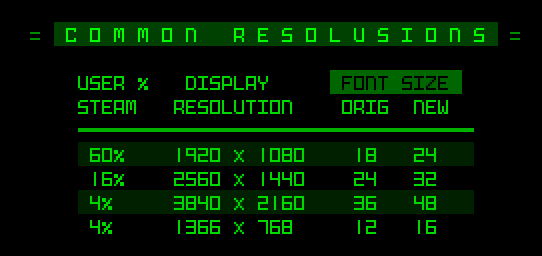
A abstract of the commonest resolutions and the corresponding font dimension enhance enabled by a 45-row structure (amongst just a few even lesser-used resolutions than these prime 4, the rise would possibly as a substitute be nearer to twenty%). It’s fascinating to match this chart information to an identical one I made again in 2014 in an article about fonts, when the preferred decision 1080p stood at a a lot decrease 33%, and 768p was ranked a a lot nearer 25%. 1440p/2160p had been barely footnotes by comparability and there was a considerably wider unfold of resolutions in use.
The rise in font dimension ends in a 44% discount in complete area to show data, and a 54% lower in seen map space, which is quite a bit, however the latter is no less than much less extreme than that brought on by Part 2 map zooming, which drops seen map space by 75%! The principle distinction is that Part 2 zooming could be toggled in actual time, whereas this data loss to accommodate a 45-row structure by default will not be able to seeing full ranges as initially designed.
That mentioned, so long as the QoL options constructed round map zooming work out effectively sufficient, they will also be of assist in the Part 3 UI, which technically already handles most ranges pretty effectively, and retains the bottom sight vary totally inside its boundaries.
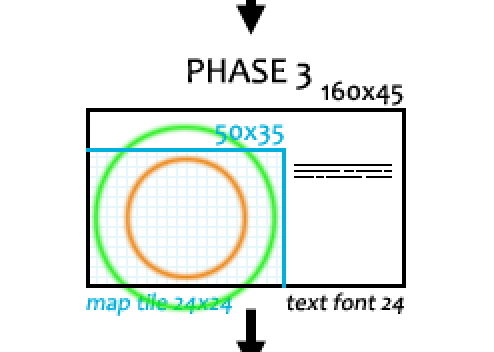
General I consider if given a alternative between utilizing a Part 1/2 interface or Part 3, the latter might be a preferable default (aside from amongst a great portion of present/frequent gamers who’re fairly used to having simple and environment friendly entry to all the data offered by the common interface).
And as soon as gamers are utilizing this Part 3 structure, map zooming will possible grow to be much less helpful general (docked earlier than it’s even been launched xD). For one it could shrink the map view much more ridiculously, whereas turning dimension 24 tiles in our 1080p instance above into 48px tiles, which is kinda large 😛
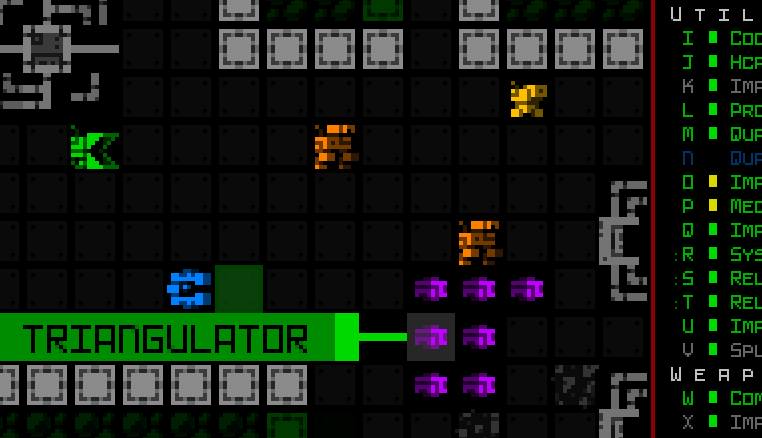
Combining map zooming with a 45-row interface is… yeah. (pattern assuming 1080p decision, open for precise dimension, which is even bigger than it seems right here)
That’s most likely overkill for many wants, although I can see zooming often coming in helpful for some individuals who nonetheless favor the common UI structure. In any case we’ll have stats on preferences sooner or later, and it’ll be very fascinating to see how utilization of assorted modes, and map zooming, performs out. (I can say that to date among the many patrons who’ve entry to check builds with zooming/Part 2 enabled, virtually nobody is making critical use of the function, however that’s not saying a complete lot as a result of they had been frequent gamers used to the enjoying with out zooming to start with.)
One welcome facet impact of the font dimension enhance is that 1080p gamers, who as famous kind the bulk, can be utilizing dimension 24, which is a 2x upscale of the bottom tile dimension, in different phrases the unique dimension for which the tile designs had been optimized! Each myself and Kacper (the tileset artist who created most of them) are very blissful about this 🙂 (2160p gamers will even have entry to such a a number of as one in every of their choices)
So the following job on this course of is to determine the right way to squeeze Cogmind’s regular 60-row interface into solely 45. Say goodbye to fifteen rows from… someplace 😛
It will require a good variety of window and content material changes, but it surely’s doable, with the largest change being a semi-modal stock. I’ll cowl that a part of the design in my subsequent article, together with mockups and a extra detailed take a look at simply what we have to change.
One potential disadvantage of our map view returning to its authentic “pre-widescreen” width of fifty is that it goes in opposition to the movement of Cogmind’s on-map QoL design work. As a result of just about everybody has a horizontal rectangular map view wider than the realm initially required by design, over time we’ve benefited from some new interface components that seem instantly over the perimeters and/or corners of the map–alert messages, full fight log, particular mode UIs, audio log, achievement popups… These will now be nearer to Cogmind and probably crowd the view underneath some circumstances, so we’ll must see how they fare and whether or not some varieties of latest changes are required.
Anyway, after being pleasantly shocked by the map zooming function of Part 2, I sit up for seeing how Part 3 seems 😀
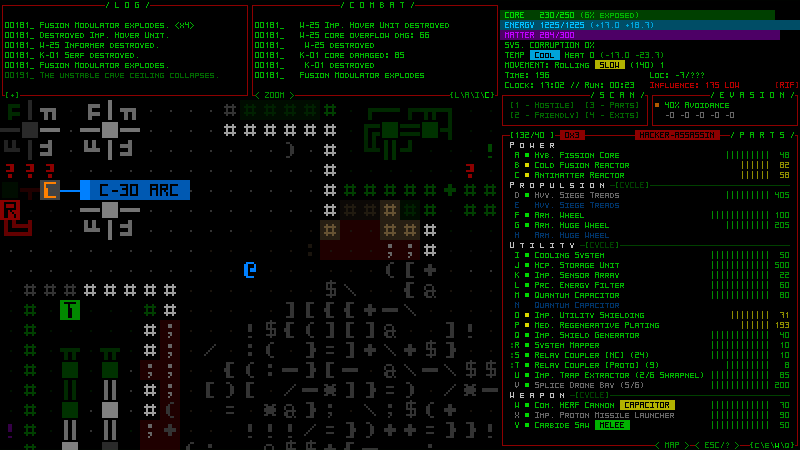
Humorous sufficient, with a brand new 45-row minimal terminal peak Cogmind may very well be performed utilizing the scale 10 font in a window as small as 450p! (mockup proven right here with zoomed map, open for “full dimension”… okay the crisp model) The unique minimal was 600p.
Part 4
Part 3 is certainly being labored on now, with plans to launch it in early 2024. There isn’t a timeline for Part 4, and whether or not or not it may even occur is dependent upon the end result of Part 3, however purely in theoretical phrases it looks as if a pure development from Part 3 that isn’t fully out of the query.
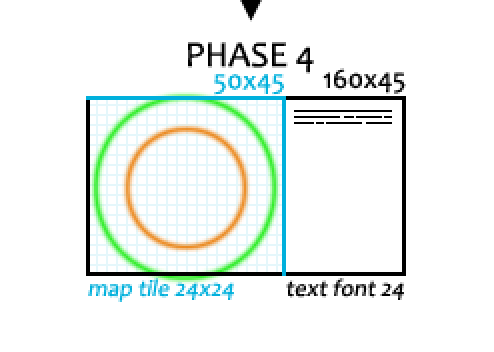
Within the curiosity of reclaiming extra of our map view, I just like the idea of constructing the top-side home windows modal as effectively, and see it as an affordable chance, if requiring but extra compromises to comfort and gameplay effectivity.
On the similar time, doing this could have some good benefits over Part 3, like virtually totally restoring our authentic 50×50 map view, and in addition assuaging a few of aforementioned nook/facet stress brought on by different on-map UI components.
That is the primary in a multi-part collection about constructing Cogmind’s totally upscaled semi-modal interface structure:



